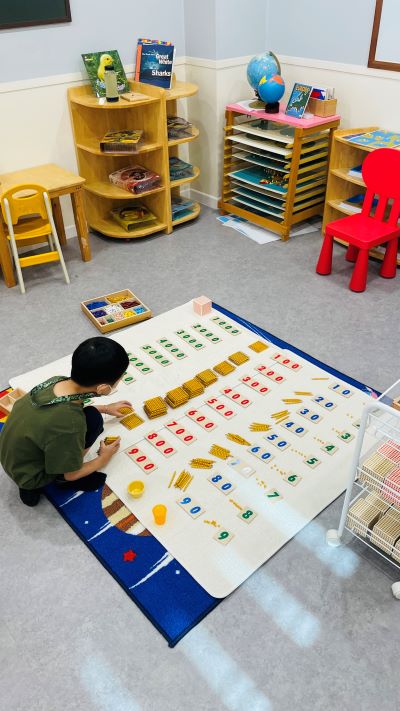Montessori Math: Guiding Early Childhood Learners from Concrete to Abstract Mathematical Thinking
By Kim Yul
Every child in the world is born with mathematical instincts. They can count, recognize, and compare all sorts of numbers and amounts. Children instinctively begin to count and distinguish between the big and small numbers, similar to when they learn a language. For example, research tells us that by 6-12 months of age, children can recognize small groups of numbers without counting. The fact that children count their footsteps as they climb stairs or walk down the street, or that they say the biggest number that they know when they try to get something, is a very natural phenomenon. These behaviors are common in most children, and the Montessori educational method has created a variety of devices for the natural evolution of these children’s mathematical thinking.
Through the developmental stages and sensitive periods that vary according to the age of children, their way of thinking develops from concrete to abstract. Along these developmental stages, the Montessori mathematics process has changed in many ways. Since children in a sensitive period cannot think abstractly, they have to learn precise, basic concepts. Children develop their own mathematical minds through clear mathematical concepts such as solid numbers and amounts. Based on the Montessori education philosophy, many materials in the early childhood classroom are hand-operated work, and children make and absorb the concepts through these sensory materials. The approach through the process of touching and feeling with one’s hands is very logical and effective. Children develop concrete concepts and establish a solid foundation through this process that can be seen by themselves. After completing this process, children move to abstract thinking, and their thoughts become broader.

As children enter the second stage of development, the materials for mathematics in the classroom become more diverse, and their contents become more numerous. Through new materials such as bead frames and stamp games, children learn various units such as tens, hundreds, thousands, and tens of thousands, and they accept the corresponding color code system. Especially by checking the material of the actual size model with the color code for each place value with their own eyes, they can think about the size difference of each unit in an abstract way. Then students are introduced to the concept of basic calculation and “exchange,” which is the Montessori method’s term for borrowing from the next place value. For example, stamp games are very good educational material that children can use to explore the concept of calculation in various ways. While children place the stamps one by one, they can identify the quantities visually, understand the concept, and finally realize how it works. It is very wonderful to observe a student who is learning division with the stamp game. In the process of division with two-digit divisors, children take different colors of bracelets or towels to share their roles, and they solve the problem together. This method has the advantage that the process itself can be understood very easily.
As an early childhood educator, these are just some of the many Montessori methods I prefer to use when guiding children from concrete to abstract mathematical thinking.



